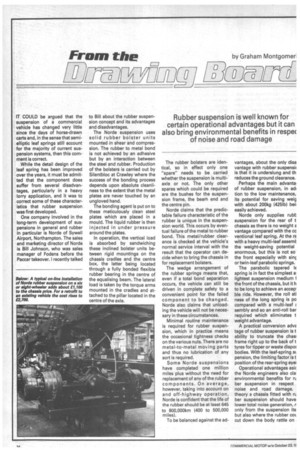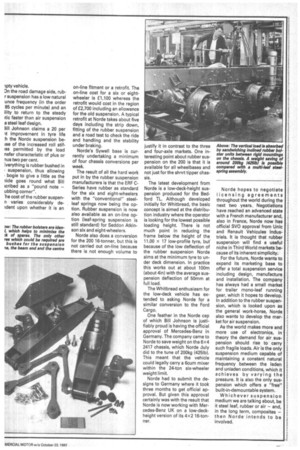From the by Graham Montgomeri 8 0 OLIZI 0
Page 22

Page 23

If you've noticed an error in this article please click here to report it so we can fix it.
Rubber suspension is well known for certain operational advantages but it can also bring environmental benefits in respec of noise and road damage
IT COULD be argued that the suspension of a commercial vehicle has changed very little since the days of horse-drawn carts and, in the sense that semielliptic leaf springs still account for the majority of current suspension systems, then this comment is correct.
While the detail design of the leaf spring has been improved over the years, it must be admitted that the component does suffer from several disadvantages, particularly in a heavy lorry application, and it was to correct some of these characteristics that rubber suspension was first developed.
One company involved in the long-term development of suspensions in general and rubber in particular is Norde of Sywell Airport, Northampton. The sales and marketing director of Norde is Bill Johnson, who was sales manager of Fodens before the Paccar takeover. I recently talked to Bill about the rubber suspension concept and its advantages and disadvantages.
The Norde suspension uses solid rubber bolster units mounted in shear and compression. The rubber to metal bond is not achieved by an adhesive but by an interaction between the steel and rubber. Production of the bolsters is carried out by Silentbloc at Crawley where the success of the bonding process depends upon absolute cleanliness to the extent that the metal plates are never touched by an ungloved hand.
The bonding agent is put on to these meticulously clean steel plates which are placed in a mould. The liquid rubber is then injected in under pressure around the plates.
In operation, the vertical load is absorbed by sandwiching these inclined bolster units between rigid mountings on the chassis cradles and the centre box, the latter being located through a fully bonded flexible rubber bearing in the centre of the equalising beam. The lateral load is taken by the torque arms mounted in the cradles and attached to the pillar located in the centre of the axle. The rubber bolsters are identical, so in effect only one "spare" needs to be carried whether the suspension is multiaxle or not. The only other spares which could be required are the bushes for the suspension frame, the beam end and the centre pin.
Norde claims that the predictable failure characteristic of the rubber is unique in the suspension world. This occurs by eventual failure of the metal to rubber bond. This metal/rubber clearance is checked at the vehicle's normal service interval with the result that the operator can decide when to bring the chassis in for replacement bolsters.
The wedge arrangement of the rubber springs means that, even if a total bond separation occurs, the vehicle can still be driven in complete safety to a convenient point for the failed component to be changed. Norde also claims that unloading the vehicle will not be necessary in these circumstances.
Minimal routine maintenance is required for rubber suspension, which in practice means the occasional tightness checks on the various nuts. There are no metal-to-metal moving parts and thus no lubrication of any sort is required.
Some Norde suspensions have completed one million miles plus without the need for replacement of any of the rubber components. On average, however, taking into account on and off-highway operation, Norde is confident that the life of the rubber should be at least 645 to 800,000km (400 to 500,000 miles).
To be balanced against the ad vantages, about the only disa vantage with rubber suspensi( is that it is underslung and th reduces the ground clearance.
Perhaps the main advanta! of rubber suspension, in adi tion to the low maintenance, its potential for saving weig with about 200kg (4251b) beil easily achieved.
Norde only supplies rubb suspension for the rear of t chassis as there is no weight a vantage compared with the cc ventional leaf spring. At the re with a heavy multi-leaf assemt the weight-saving potential enormous, but this is not so the front especially with sinc or twin-leaf parabolic springs.
The parabolic tapered IE spring is in fact the simplest a! lightest suspension medium the front of the chassis, but it h to be long to achieve an accepi ble ride. However, the roll sti ness of the long spring is po compared with a multi-leaf sembly and so an anti-roll bar required which eliminates t weight advantage.
A practical conversion adva tage of rubber suspension is t ability to truncate the chas: frame right up to the back of t tyres for tipper or waste dispol bodies. With the leaf-spring si pension, the limiting factor is t position of the rear-spring eye; Operational advantages asic the Norde engineers also dal environmental benefits for ru ber suspension in respect noise and road damage. theory a chassis fitted with ru ber suspension should have lower total noise generation, r only from the suspension its but also where the rubber cm cut down the body rattle on ipty vehicle.
On the road damage side, rubr suspension has a low natural unce frequency (in the order 85 cycles per minute) and an ility to return to the steady itic faster than air suspension a steel leaf design.
NI Johnson claims a 20 per it improvement in tyre life .h the Norde suspension beise of the increased roll stif:ss permitted by the load nsfer characteristic of plus or nus two per cent.
:verything is rubber bushed in suspension, thus allowing bogie to give a little as the fide goes round what Bill ;cribed as a "pound note — ubbing corner", he cost of the rubber suspenn varies considerably deident upon whether it is an on-line fitment or a retrofit. The on-line cost for a six or eightwheeler is £1,100 whereas the retrofit would cost in the region of £2,700 including an allowance for the old suspension. A typical retrofit at Norde takes about five days including the strip down, fitting of the rubber suspension and a road test to check the ride and handling and the stability under braking.
Norde's Sywell base is currently undertaking a minimum of four chassis conversions per week.
The result of all the hard work put in by the rubber suspension manufacturers is that the ERF CSeries have rubber as standard for the six and eight-wheelers with the "conventional" steelleaf springs now being the option. Rubber suspension is now also available as an on-line option (leaf-spring suspension is still standard) for Seddon Atkinson six and eight-wheelers.
Norde also does a conversion for the 200 16-tanner, but this is not carried out on-line because there is not enough volume to justify it in contrast to the three and four-axle markets. One interesting point about rubber suspension on the 200 is that it is available for all wheel bases and not just for the short tipper chassis.
The latest development from Norde is a low-deck-height suspension produced for the Bedford TL. Although developed initially for Whitbread, the basic concept is aimed at the distribution industry where the operator is looking for the lowest possible loading height. There is not much point in reducing the frame below the height of the 11.00 x 17 low-profile tyre, but because of the low deflection of the rubber suspension Norde aims at the minimum tyre to under deck dimension. In practice this works out at about 100m (about 4in) with the average suspension deflection of 50mm at full load.
The Whitbread enthusiasm for the low-deck vehicle has extended to asking Norde for a similar conversion to the Ford Cargo.
One feather in the Norde cap of which Bill Johnson is justifiably proud is having the official approval of Mercedes-Benz in Germany. The company came to Norde to save weight on the 6x4 2417 chassis, which Norde duly did to the tune of 200kg (4251b). This meant that the vehicle could legally carry a 6cum mixer within the 24-ton six-wheeler weight limit.
Norde had to submit the designs to Germany where it took three months to get official approval. But given this approval certainly was with the result that Norde is now working with Mercedes-Benz UK on a low-deckheight version of its 4 x 2 16-tonner. Norde hopes to negotiate licensing agreements throughout the world during the next two years. Negotiations have reached an advanced state with a French manufacturer and, also in France, Norde now has official SVO approval from Unic and Renault Vehicules Industriels. It is thought that rubber suspension will find a useful niche in Third World markets because of its inherent simplicity.
For the future, Norde wants to expand its marketing base to offer a total suspension service including design, manufacture and installation. The company has always had a small market for trailer mono-leaf running gear, which it hopes to develop. In addition to the rubber suspension, which is looked upon as the general work-horse, Norde also wants to develop the market for air suspension.
As the world makes more and more use of electronics, in theory the demand for air suspension should rise to carry such fragile loads. Air is the only suspension medium capable of maintaining a constant natural frequency between the laden and unladen conditions, which it achieves by varying the pressure. It is also the only suspension which offers a "free" built-in-demountable system.
Whichever suspension medium we are talking about, be it steel leaf, rubber or air — and, in the long term, composites — then Norde intends to be involved.


















































































































